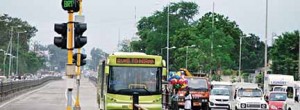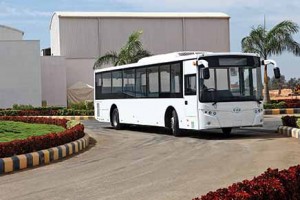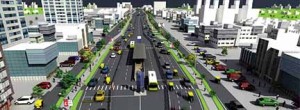Hubli-Dharwad BRT system is set to be operational in a few months from now.
Story by: Bhushan Mhapralkar
Bus Rapid Transport (BRT) system is not new to India. The Rainbow BRT system at Pune is said to be the first to began operation in India. Under the aegis of Pune Mahanagar Parivahan Mahamandal Limited (PMPML), the system envisages 113 km of dedicated bus corridors along with buses, bus stations, terminals and intelligent transit management system. The first route of the Delhi BRT system began operation in 2008. It drew inspiration from a similar system in Curitiba, Brazil, which had been in operation since 1975. RITES (formerly Rail India Technical and Economic Service) and the Indian Institute of Technology Delhi (IIT Delhi) were appointed to design and implement the system. Set to be scrapped for a reason that it is difficult to access the platforms, the Delhi BRT system may soon be history. Like the Delhi BRT system, the Pune BRT system also faced resistance initially. In 2010, the Jaipur BRT system began operation. A year later, the Vijaywada BRT system was also operational. Including Delhi BRT system, industry sources claim that there are 24 BRT networks in India. Of these nine are said to be under construction, or are in the planning stages. The Hubli-Dharwad BRT system is claimed to be progressing the fastest.
The design
The construction of Hubli-Dharwad BRT system is funded by the respective state government. To be precise, the Government of Karnataka has a 70 per cent stake in the Special Purpose Vehicle (SPV), the Hubli-Dharwad BRTS Company Limited (HDBRTSCO). HDBRTSCO has an authorised capital of Rs.200 million, and is implementing the project. The remaining 30 per cent stake is shared by Hubli-Dharwad Municipal Corporation (HDMC), North-Western Karnataka Road Transport Corporation (NWKRTC) and Hubli-Dharwad Urban Development Authority (HDUDA). The operation and maintenance work will be done by Hubli-Dharwad Municipal Corporation (HDMC) in association with Karnataka State Road Transport Corporation (KSRTC). Claimed to operate over a distance of 70 km, the Hubli-Dharwad BRTS, claim sources, was originally designed to operate over a distance of 22.25 km, originating from Hubli CBT and ending at Dharwad CBT. Overtime the corridor was extended to include the Agricultural University, Dharwad. A four-lane bus corridor will thus run in the middle of an eight-lane freeway, mention sources. They state that the freeway will include two lanes for mixed traffic in both the directions. The width of the corridor is set to vary from 24.5 m to 44.0 m. Four underpasses for regular traffic are planned at Unkal Lake, Unkal-Cross Road, Bairidevarakoppa, and Navanagar. Designed to have two lines – trunk and feeder, the BRT system will have 33 stations. Out of the 33 stations planned, 12 stations will be located on the 44 m wide express corridor starting from Taj Hotel and ending at the Gandhinagar Cross, Dharwad.
Smart transport
Located at the middle of the BRT corridor, the stations will be four-meter wide. Each station will act as reference point for GPS. Each station will have LED displays, which will display the schedule of bus arrival and departure. The BRTS (trunk) corridor, claim sources, will operate as a ‘closed system’ whereas the feeder and city bus services will operate in the ‘open system’. The ridership for the project was said to be 237,968 in 2014 against a fleet size of 190 buses. In 2017, the ridership is estimated to be 564,000 against a fleet size of 452 buses. Over 200,000 people are expected to use the corridor daily. Considering the rush the buses currently plying between Dharwad CBT and Hubli CBT experience in either direction, the BRT system will have to have a high frequency of buses on the corridor. With the ridership estimated to reach 400,000 people by 2021, the Hubli-Dharwad BRT system is no doubt one of the important such projects in the country.
Designed with central bus lanes to minimise interference of traffic plying on the mixed traffic lanes, the system will include segregated bus ways, controlled bus stations, physical and fare integration with BRT feeder, off-board ticketing through smart cards and paper tickets, and high quality buses (standard as well as articulated). The corridor is designed to operate regular and express services. Consisting of two lanes for BRTS buses on either side of the median bus station facilitating overtaking lanes for express services, the key infrastructure includes stations with two and three-bay configuration to support standard and articulated bus docking. Tickets shall be issued at stations, and commuters with a valid ticket or a smart card can only access the platform through automatic sliding doors. Two new depots at Dharwad and Hubli respectively are being constructed for the parking and maintenance of the buses. The depots will be equipped with modern facilities like automatic washing and automated oil dispensing system. HDBRTS is also developing a divisional workshop for heavy maintenance at Hubli.
An order for 30 (18 m long) vestibule buses has been placed by HDBRTS with Tata Motors. The buses will have a floor height of 900 mm. An order for 100 (12 m long) two-axle buses with a floor height of 900 mm has been placed with Volvo Buses India. These buses, claim industry sources, are of the UD make. Sources also mentioned that an order for 60 (9 m long and 650 mm floor height) midi buses has been placed with Ashok Leyland. The buses will be laced with an Intelligent Transport System (ITS) as part of the need to comply with UBS II specifications. To make the Hubli-Dharwad BRT system truly smart, the ITS will include automated vehicle location system, passenger information system, automatic fare collection system, transit management system, and an incident management system. With the learnings of the BRT system at Ahmedabad, Pune and Delhi put to use, the Hubli-Dharwad BRT system, claim industry sources, will have buses that are fitted with a camera, DVR and speakers. The driver will have an address system at his disposal, may he feel the need to make an announcement or provide information.
Engineered to have a distance based fare structure, the BRT system will offer smart cards and bar-coded paper tickets to commuters. On-board ticketing will be used for the feeder service, integrated with the BRT corridor. HDBRTS will introduce complete transit management system to automate schedule of buses and manpower. Different organisation functions like administration, finance and human resources will be integrated for efficient and smooth functioning. An incident management system is designed to monitor day-to-day operations, and supplement passenger safety other than aiding effective enforcement with the help of technologies like CCTV and passenger announcement system. HDBRTS will setup a control centre to monitor all systems. Called the central monitoring center, it will provide space and connectivity for around 32 workstations, which will monitor the ITS systems.
Commuter-centric
Expected to operate with the prime aim of being commuter-centric, the BRT system at Hubli-Dharwad is slated to be operational by the end of this year. Opinion is divided on the time-line of September. Some industry sources with the knowledge of the development claim that it may take a little longer to ensure a smooth start. They stress on factors like accessibility and safety, and the need for integration with other new and existing modes of transportation to increase transit ridership with convenience. It is necessary that this BRT system does not suffer from the resistance faced by the system at Pune during the initial period, said another source. He also drew attention to the factors like difficulty in accessing the station, which caused the Delhi BRT system to falter. Attention was also drawn towards the need to provide parking space (on ground or under ground) near the station for two wheelers and cars to make it easier for commuters to avail of the BRT services. Also, stops for the feeder bus service.
The success of the Hubli-Dharwad BRT system will lie in the last mile transportation opined a source. He pointed at the Ahmedabad and Indore BRT system’s inability to address last mile connectivity. Much attention was paid at Ahmedabad to provide dedicated routes for buses to operate with hardly any shaded pedestrian footpaths sans obstacles, he said. The same is now being rectified, he added. If the demand for CNG buses in the interest of environment picked up albeit after the order for 30 diesel-powered vestibule buses, 100 diesel-powered 12 m long buses was placed, the fact is, diesel-powered buses are proving to be more economical and practical considering the operating costs of CNG and its availability. Diesel technology too has been progressing, and emission levels with the migration to BSIV have further dipped. While the scope for electric buses looks brighter, the Hubli-Dharwad BRT system could do with efficient management and commuter friendly operations.























